Facile Synthesis of Fe3O4@Au/PPy-DOX Nanoplatform with Enhanced Glutathione Depletion and Controllable Drug Delivery for Enhanced Cancer Therapeutic Efficacy
Abstract
:1. Introduction
2. Materials and Methods
2.1. Synthesis of Fe3O4@Au/PPy Nanocomposites
2.2. Photothermal Performance
2.3. Detection of ROS
2.4. Consumption of GSH and Generation of OH
2.5. DOX Loading and Release
2.6. Cell Experiments
2.7. Animal Models
2.8. In Vivo Synergistic Antitumor Effect
3. Results and Discussion
4. Conclusions
Supplementary Materials
Author Contributions
Funding
Conflicts of Interest
References
- Zhang, Y.; Wan, Y.; Chen, Y.; Blum, N.T.; Lin, J.; Huang, P. Ultrasound-enhanced chemo-photodynamic combination therapy by using albumin ″Nanoglue″-based nanotheranostics. ACS Nano 2020, 14, 5560–5569. [Google Scholar] [CrossRef] [PubMed]
- Liu, X.L.; Dong, X.; Yang, S.C.; Lai, X.; Liu, H.J.; Gao, Y.; Feng, H.Y.; Zhu, M.H.; Yuan, Y.; Lu, Q.; et al. Biomimetic liposomal nanoplatinum for targeted cancer chemophototherapy. Adv. Sci. 2021, 8, 2003679. [Google Scholar] [CrossRef] [PubMed]
- Feng, J.; Yu, W.; Xu, Z.; Wang, F. An intelligent ZIF-8-gated polydopamine nanoplatform for in vivo cooperatively enhanced combination phototherapy. Chem. Sci. 2020, 11, 1649–1656. [Google Scholar] [CrossRef] [Green Version]
- Gao, S.; Jin, Y.; Ge, K.; Li, Z.; Liu, H.; Dai, X.; Zhang, Y.; Chen, S.; Liang, X.; Zhang, J. Self-supply of O2 and H2O2 by a nanocatalytic medicine to enhance combined chemo/chemodynamic therapy. Adv. Sci. 2019, 6, 1902137. [Google Scholar] [CrossRef] [PubMed] [Green Version]
- Zhao, Z.; Wang, W.; Li, C.; Zhang, Y.; Yu, T.; Wu, R.; Zhao, J.; Liu, Z.; Liu, J.; Yu, H. Reactive oxygen species-activatable liposomes regulating hypoxic tumor microenvironment for synergistic photo/chemodynamic therapies. Adv. Funct. Mater. 2019, 29, 1905013. [Google Scholar] [CrossRef]
- Swartz, M.A.; Iida, N.; Roberts, E.W.; Sangaletti, S.; Wong, M.H.; Yull, F.E.; Coussens, L.M.; DeClerck, Y.A. Tumor microenvironment complexity: Emerging roles in cancer therapy. Cancer Res. 2012, 72, 2473–2480. [Google Scholar] [CrossRef] [Green Version]
- Quail, D.F.; Joyce, J.A. Microenvironmental regulation of tumor progression and metastasis. Nat. Med. 2013, 19, 1423–1437. [Google Scholar] [CrossRef]
- Martin, J.D.; Cabral, H.; Stylianopoulos, T.; Jain, R.K. Improving cancer immunotherapy using nanomedicines: Progress, opportunities and challenges. Nat. Rev. Clin. Oncol. 2020, 17, 251–266. [Google Scholar] [CrossRef]
- Tang, Z.; Liu, Y.; He, M.; Bu, W. Chemodynamic therapy: Tumour microenvironment mediated Fenton and Fenton-like reactions. Angew. Chem. Int. Ed. Engl. 2018, 58, 946–956. [Google Scholar] [CrossRef]
- Zhou, Y.F.; Fan, S.Y.; Feng, L.L.; Huang, X.L.; Chen, X.Y. Manipulating intratumoral Fenton chemistry for enhanced chemodynamic and chemodynamic-synergized multimodal therapy. Adv. Mater. 2021, 33, 2104223. [Google Scholar] [CrossRef]
- Dai, Y.L.; Yang, Z.; Cheng, S.Y.; Wang, Z.L.; Zhang, R.L.; Zhu, G.Z.; Wang, Z.T.; Yung, B.C.; Tian, R.; Jacobson, O.; et al. Toxic reactive oxygen species enhanced synergistic combination therapy by self-assembled metal-phenolic network nanoparticles. Adv. Mater. 2018, 30, 1704877. [Google Scholar] [CrossRef]
- Hu, R.Z.; Fang, Y.; Huo, M.F.; Yao, H.L.; Wang, C.M.; Chen, Y.; Wu, R. Ultrasmall Cu2-XS nanodots as photothermal-enhanced Fenton nanocatalysts for synergistic tumor therapy at NIR-II biowindow. Biomaterials 2019, 206, 101–114. [Google Scholar] [CrossRef] [PubMed]
- Sang, Y.J.; Cao, F.F.; Li, W.; Zhang, L.; You, Y.W.; Deng, Q.Q.; Dong, K.; Ren, J.S.; Qu, X.G. Bioinspired construction of a nanozyme-based H2O2 homeostasis disruptor for intensive chemodynamic therapy. J. Am. Chem. Soc. 2020, 142, 5177–5183. [Google Scholar] [CrossRef] [PubMed]
- Mura, S.; Nicolas, J.; Couvreur, P. Stimuli-responsive nanocarriers for drug delivery. Nat. Mater. 2013, 12, 991–1003. [Google Scholar] [CrossRef] [PubMed]
- Mo, R.; Gu, Z. Tumor microenvironment and intracellular signal-activated nanomaterials for anticancer drug delivery. Mater. Today 2016, 19, 274–283. [Google Scholar] [CrossRef]
- Liu, Y.; Zhen, W.Y.; Jin, L.H.; Zhang, S.T.; Sun, G.Y.; Zhang, T.Q.; Xu, X.; Song, S.Y.; Wang, Y.H.; Liu, J.H.; et al. All-in-one theranostic nanoagent with enhanced reactive oxygen species generation and modulating tumor microenvironment ability for effective tumor eradication. ACS Nano 2018, 12, 4886–4893. [Google Scholar] [CrossRef]
- Tang, Z.M.; Zhang, H.L.; Liu, Y.Y.; Ni, D.L.; Zhang, H.; Zhang, J.W.; Yao, Z.W.; He, M.Y.; Shi, J.L.; Bu, W.B. Antiferromagnetic pyrite as the tumor microenvironment-mediated nanoplatform for self-enhanced tumor imaging and therapy. Adv. Mater. 2017, 29, 1701683. [Google Scholar] [CrossRef]
- Han, Q.; Shen, X.; Zhu, W.Y.; Zhu, C.H.; Zhou, X.M.; Jiang, H.J. Magnetic sensing film based on Fe3O4@Au-GSH molecularly imprinted polymers for the electrochemical detection of estradiol. Biosens. Bioelectron. 2016, 79, 180–186. [Google Scholar] [CrossRef]
- Zhao, L.Y.; Song, X.X.; Ouyang, X.L.; Zhou, J.H.; Li, J.P.; Deng, D.W. Bioinspired virus-like Fe3O4/Au@C nanovector for programmable drug delivery via hierarchical targeting. ACS Appl. Mater. Interfaces 2021, 13, 49631–49641. [Google Scholar] [CrossRef]
- Nieciecka, D.; Celej, J.; Zuk, M.; Majkowska-Pilip, A.; Zelechowska-Matysiak, K.; Lis, A.; Osial, M. Hybrid system for local drug delivery and magnetic hyperthermia based on spions loaded with doxorubicin and epirubicin. Pharmaceutics 2021, 13, 480. [Google Scholar] [CrossRef]
- Singh, N.; Sallem, F.; Mirjolet, C.; Nury, T.; Sahoo, S.K.; Millot, N.; Kumar, R. Polydopamine modified superparamagnetic iron oxide nanoparticles as multifunctional nanocarrier for targeted prostate cancer treatment. Nanomaterials 2019, 9, 138. [Google Scholar] [CrossRef] [PubMed] [Green Version]
- Nogueira, J.; Soares, S.F.; Amorim, C.O.; Amaral, J.S.; Silva, C.; Martel, F.; Trindade, T.; Daniel-da-Silva, A.L. Magnetic driven nanocarriers for pH-responsive doxorubicin release in cancer therapy. Molecules 2020, 25, 333. [Google Scholar] [CrossRef] [PubMed] [Green Version]
- Kovrigina, E.; Chubarov, A.; Dmitrienko, E. High drug capacity doxorubicin-loaded iron oxide nanocomposites for cancer therapy. Magnetochemistry 2022, 8, 54. [Google Scholar] [CrossRef]
- Wang, S.Q.; Yang, L.T.; Cho, H.-Y.; Chueng, S.-T.-D.; Zhang, H.P.; Zhang, Q.Y.; Lee, K.-B. Programmed degradation of a hierarchical nanoparticle with redox and light responsivity for self-activated photo-chemical enhanced chemodynamic therapy. Biomaterials 2019, 224, 119498. [Google Scholar] [CrossRef] [PubMed]
- Luo, K.Y.; Zhao, J.L.; Jia, C.Z.; Chen, Y.K.; Zhang, Z.L.; Zhang, J.; Huang, M.X.; Wang, S.G. Integration of Fe3O4 with Bi2S3 for multi-modality tumor theranostics. ACS Appl. Mater. Interfaces 2020, 12, 22650–22660. [Google Scholar] [CrossRef] [PubMed]
- Du, W.X.; Liu, T.Z.; Xue, F.F.; Cai, X.J.; Chen, A.; Zheng, Y.Y.; Chen, H.R. Fe3O4 mesocrystals with distinctive magnetothermal and nanoenzyme activity enabling self-reinforcing synergistic cancer therapy. ACS Appl. Mater. Interfaces 2020, 12, 19285–19294. [Google Scholar] [CrossRef] [PubMed]
- Huang, X.H.; El-Sayed, I.H.; Qian, W.; El-Sayed, M.A. Cancer cell imaging and photothermal therapy in the near-infrared region by using gold nanorods. J. Am. Chem. Soc. 2006, 128, 2115–2120. [Google Scholar] [CrossRef] [PubMed]
- Boisselier, E.; Astruc, D. Gold nanoparticles in nanomedicine: Preparations, imaging, diagnostics, therapies and toxicity. Chem. Soc. Rev. 2009, 38, 1759–1782. [Google Scholar] [CrossRef]
- Jin, R.C.; Cao, Y.W.; Mirkin, C.A.; Kelly, K.L.; Schatz, G.C.; Zheng, J.G. Photoinduced conversion of silver nanospheres to nanoprisms. Science 2001, 294, 1901–1903. [Google Scholar] [CrossRef] [Green Version]
- Kam, N.W.S.; O’Connell, M.; Wisdom, J.A.; Dai, H.J. Carbon nanotubes as multifunctional biological transporters and near-infrared agents for selective cancer cell destruction. Proc. Natl. Acad. Sci. USA 2005, 102, 11600–11605. [Google Scholar] [CrossRef] [Green Version]
- Moon, H.K.; Lee, S.H.; Choi, H.C. In vivo near-infrared mediated tumor destruction by photothermal effect of carbon nanotubes. ACS Nano 2009, 3, 3707–3713. [Google Scholar] [CrossRef] [PubMed]
- Wang, X.J.; Wang, C.; Cheng, L.; Lee, S.T.; Liu, Z. Noble metal coated single-walled carbon nanotubes for applications in surface enhanced raman scattering imaging and photothermal therapy. J. Am. Chem. Soc. 2012, 134, 7414–7422. [Google Scholar] [CrossRef] [PubMed]
- Robinson, J.T.; Tabakman, S.M.; Liang, Y.Y.; Wang, H.L.; Casalongue, H.S.; Vinh, D.; Dai, H.J. Ultrasmall reduced graphene oxide with high near-infrared absorbance for photothermal therapy. J. Am. Chem. Soc. 2011, 133, 6825–6831. [Google Scholar] [CrossRef] [PubMed]
- Yang, K.; Zhang, S.A.; Zhang, G.X.; Sun, X.M.; Lee, S.T.; Liu, Z.A. Graphene in mice: Ultrahigh in vivo tumor uptake and efficient photothermal therapy. Nano Lett. 2010, 10, 3318–3323. [Google Scholar] [CrossRef] [PubMed]
- Zha, Z.B.; Yue, X.L.; Ren, Q.S.; Dai, Z.F. Uniform polypyrrole nanoparticles with high photothermal conversion efficiency for photothermal ablation of cancer cells. Adv. Mater. 2013, 25, 777–782. [Google Scholar] [CrossRef]
- Chen, M.; Fang, X.L.; Tang, S.H.; Zheng, N.F. Polypyrrole nanoparticles for high-performance in vivo near-infrared photo-thermal cancer therapy. Chem. Commun. 2012, 48, 8934–8936. [Google Scholar] [CrossRef]
- Liu, X.; Wang, C.; Wang, X.Y.; Tian, C.; Shen, Y.H.; Zhu, M.Z. A dual-targeting Fe3O4@C/ZnO-DOX-FA nanoplatform with pH-responsive drug release and synergetic chemo-photothermal antitumor in vitro and in vivo. Mater. Sci. Eng. C-Mater. 2021, 118, 111455. [Google Scholar] [CrossRef]
- Zhang, L.; Blom, D.A.; Wang, H. Au-Cu2O core-shell nanoparticles: A hybrid metal-semiconductor heteronanostructure with geometrically tunable optical properties. Chem. Mater. 2011, 23, 4587–4598. [Google Scholar] [CrossRef]
- You, J.; Zhang, G.D.; Li, C. Exceptionally high payload of doxorubicin in hollow gold nanospheres for near-infrared light-triggered drug release. ACS Nano 2010, 4, 1033–1041. [Google Scholar] [CrossRef] [Green Version]
- Wang, X.D.; Mao, Y.L.; Sun, C.S.; Zhao, Q.F.; Gao, Y.K.; Wang, S.L. A versatile gas-generator promoting drug release and oxygen replenishment for amplifying photodynamic-chemotherapy synergetic anti-tumor effects. Biomaterials 2021, 276, 120985. [Google Scholar] [CrossRef]
- Zhang, C.Y.; Li, D.D.; Pei, P.; Wang, W.N.; Chen, B.J.; Chu, Z.Y.; Zha, Z.B.; Yang, X.Z.; Wang, J.B.; Qian, H.S. Rod-based urchin-like hollow microspheres of Bi2S3: Facile synthesis, photo-controlled drug release for photoacoustic imaging and chemo-photothermal therapy of tumor ablation. Biomaterials 2020, 237, 119835. [Google Scholar] [CrossRef] [PubMed]
- Huang, W.J.; Zhao, H.; Wan, J.S.; Zhou, Y.; Xu, Q.B.; Zhao, Y.B.; Yang, X.L.; Gan, L. pH- and photothermal-driven multistage delivery nanoplatform for overcoming cancer drug resistance. Theranostics 2019, 9, 3825–3839. [Google Scholar] [CrossRef] [PubMed]
- Kucharczyk, K.; Florczak, A.; Deptuch, T.; Penderecka, K.; Jastrzebska, K.; MackiewiczL, A.; Dams-Kozlowska, H. Drug affinity and targeted delivery: Double functionalization of silk spheres for controlled doxorubicin delivery into Her2-positive cancer cells. J. Nanobiotechnol. 2020, 18, 56. [Google Scholar] [CrossRef]
- Chen, D.Y.; Jin, Z.K.; Zhao, B.; Wang, Y.S.; He, Q.J. MBene as a theranostic nanoplatform for photocontrolled intratumoral retention and drug release. Adv. Mater. 2021, 33, 2008089. [Google Scholar] [CrossRef] [PubMed]
- Zhou, Z.J.; Chan, A.; Wang, Z.T.; Huang, X.L.; Yu, G.C.; Jacobson, O.; Wang, S.; Liu, Y.J.; Shan, L.L.; Dai, Y.L.; et al. Synchronous chemoradiation nanovesicles by X-ray triggered cascade of drug release. Angew. Chem. Int. Ed. 2018, 57, 8463–8467. [Google Scholar] [CrossRef] [PubMed]
- Yang, Z.; Song, J.B.; Tang, W.; Fan, W.P.; Dai, Y.L.; Shen, Z.Y.; Lin, L.S.; Cheng, S.Y.; Liu, Y.J.; Niu, G.; et al. Stimuli-responsive nanotheranostics for real-time monitoring drug release by photoacoustic imaging. Theranostics 2019, 9, 526–536. [Google Scholar] [CrossRef]
- Abdulla, H.S.; Abbo, A.I. Optical and electrical properties of thin films of polyaniline and polypyrrole. Int. J. Electrochem. Sci. 2012, 7, 10666–10678. [Google Scholar]
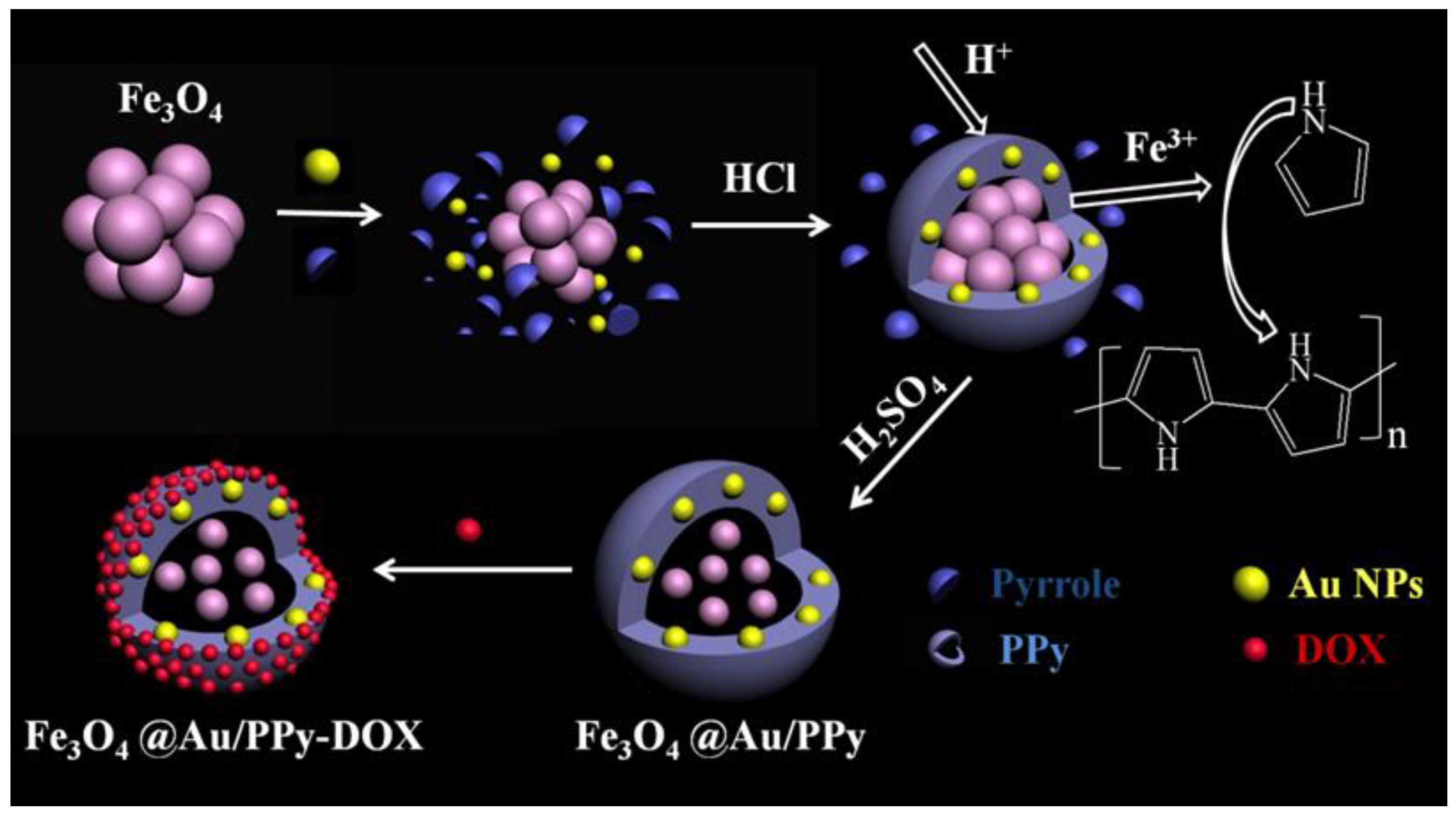
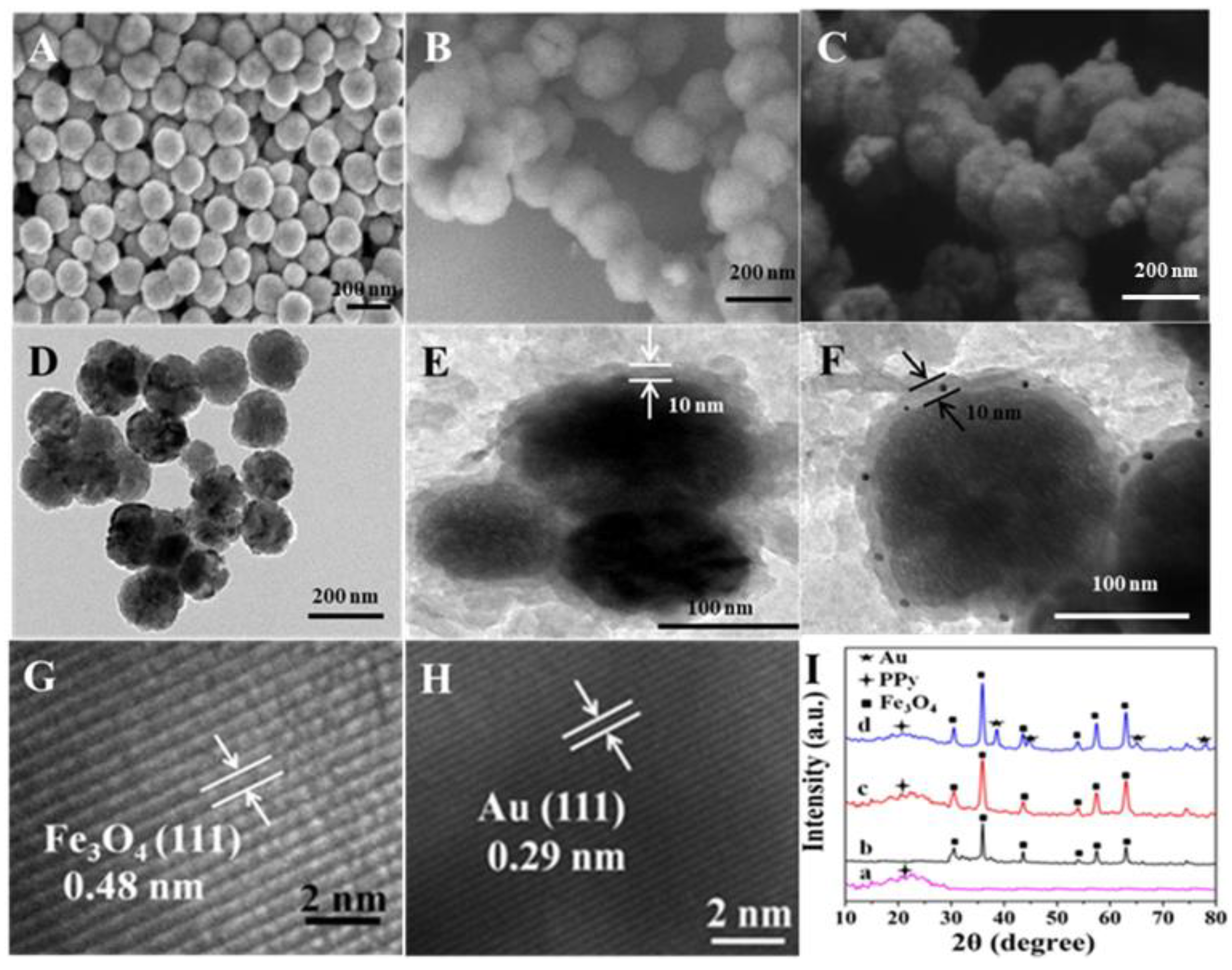

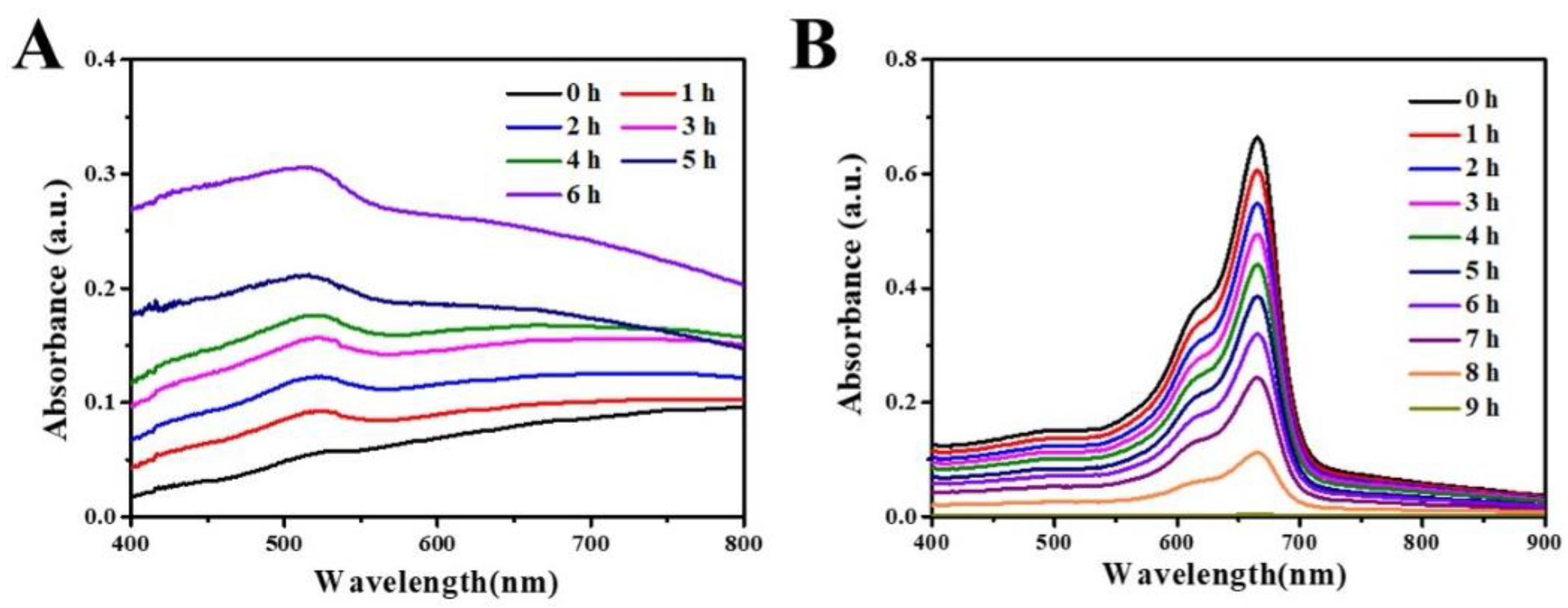
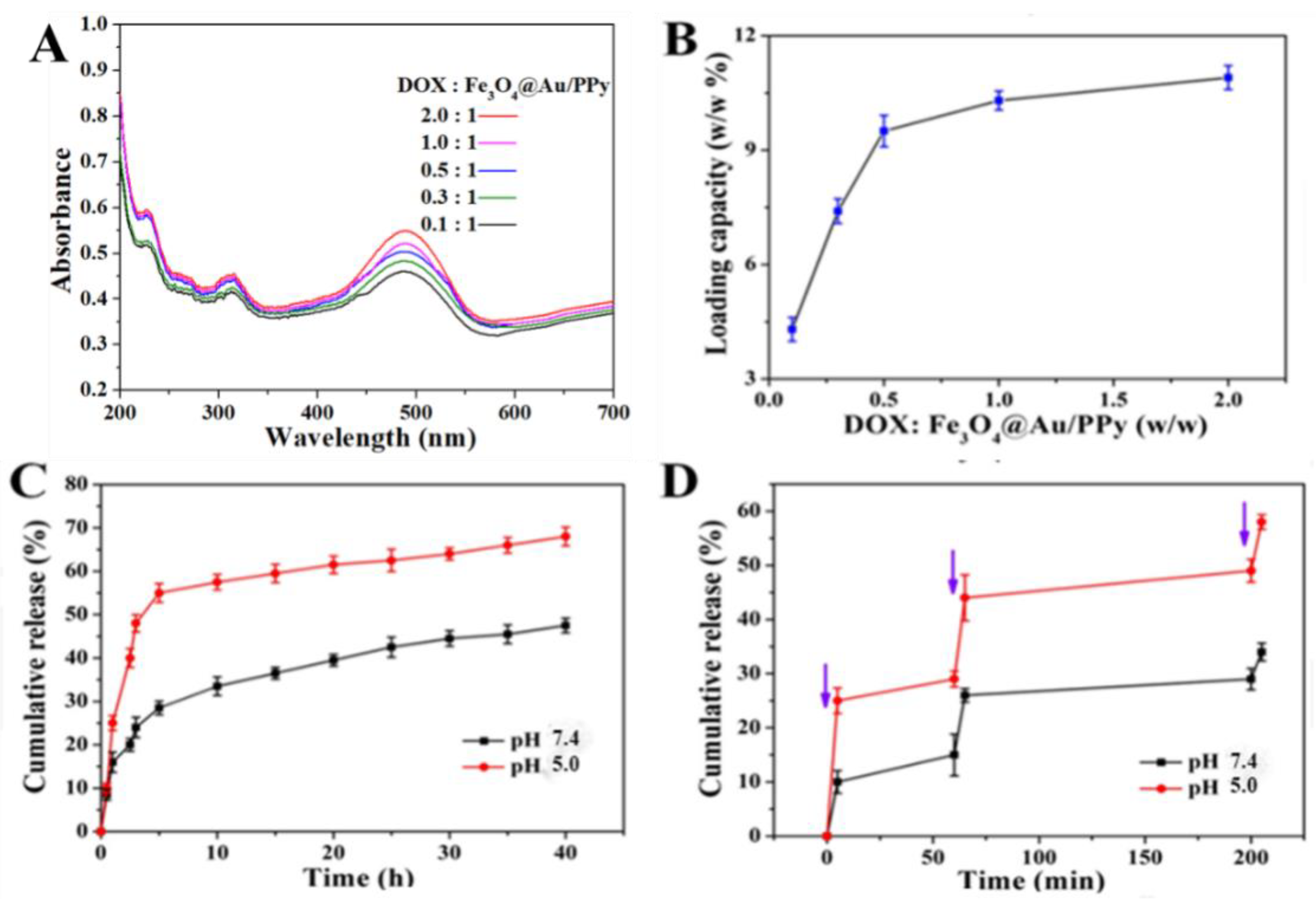
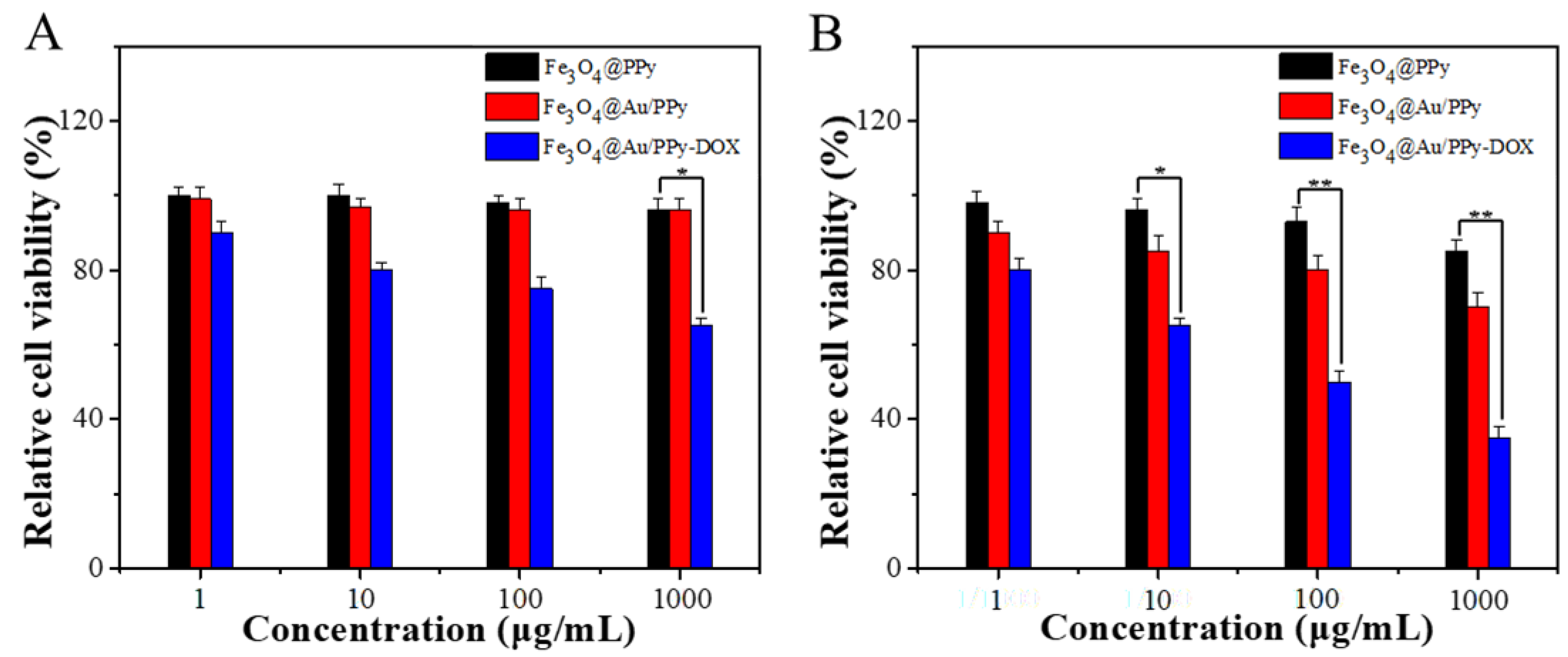
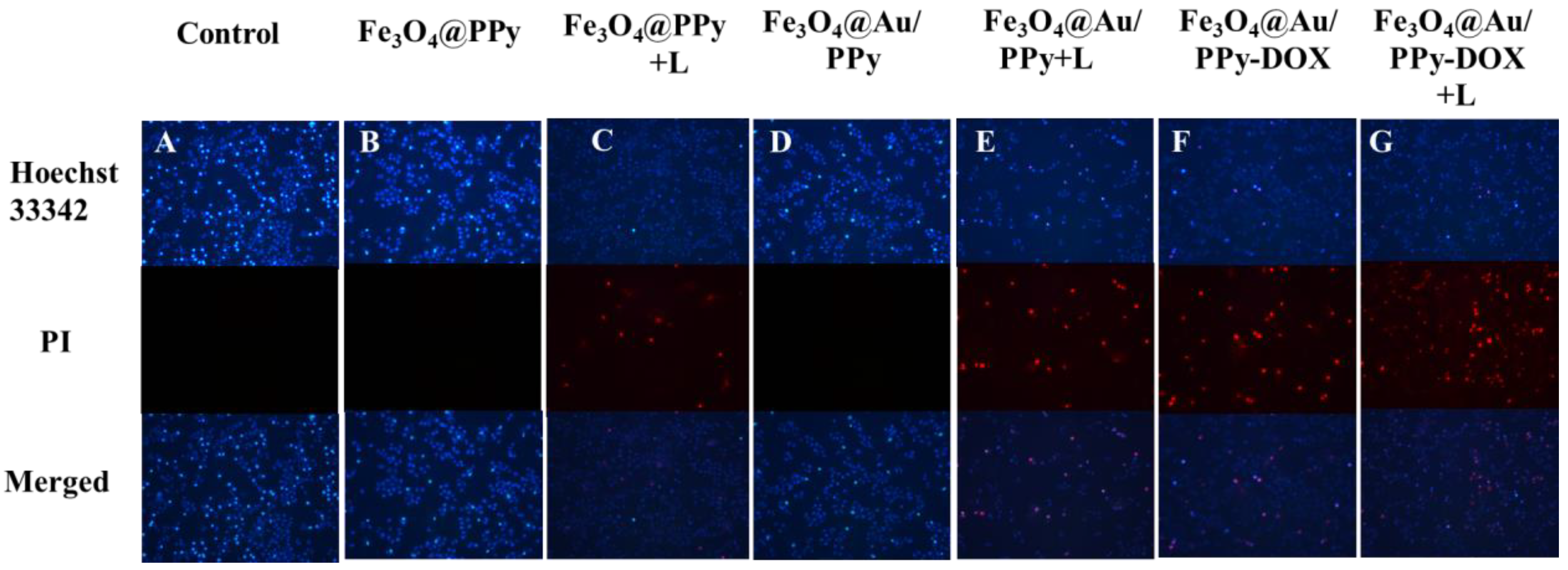
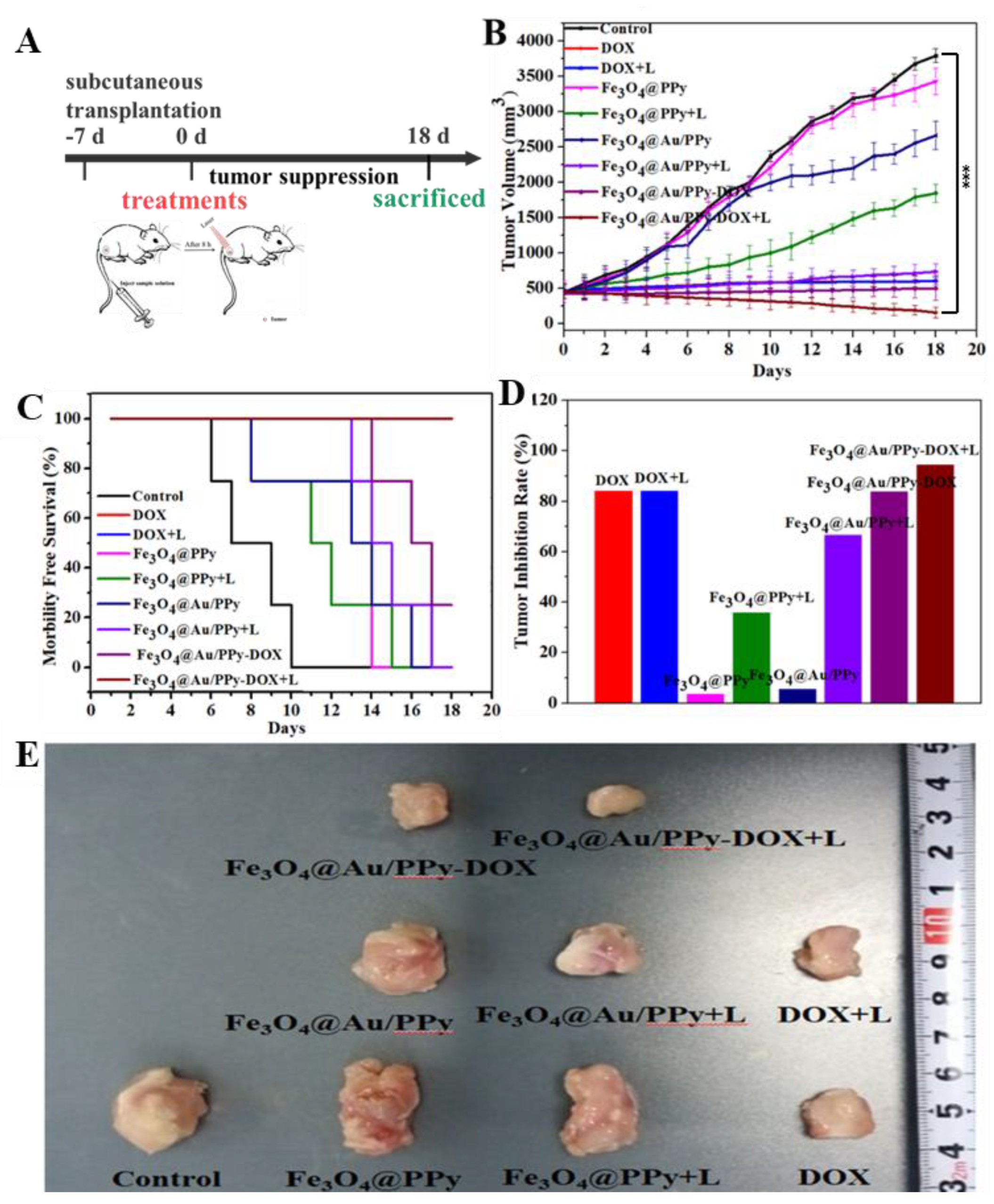
Publisher’s Note: MDPI stays neutral with regard to jurisdictional claims in published maps and institutional affiliations. |
© 2022 by the authors. Licensee MDPI, Basel, Switzerland. This article is an open access article distributed under the terms and conditions of the Creative Commons Attribution (CC BY) license (https://creativecommons.org/licenses/by/4.0/).
Share and Cite
Qi, C.; Wang, W.; Wang, P.; Cheng, H.; Wang, X.; Gong, B.; Xie, A.; Shen, Y. Facile Synthesis of Fe3O4@Au/PPy-DOX Nanoplatform with Enhanced Glutathione Depletion and Controllable Drug Delivery for Enhanced Cancer Therapeutic Efficacy. Molecules 2022, 27, 4003. https://doi.org/10.3390/molecules27134003
Qi C, Wang W, Wang P, Cheng H, Wang X, Gong B, Xie A, Shen Y. Facile Synthesis of Fe3O4@Au/PPy-DOX Nanoplatform with Enhanced Glutathione Depletion and Controllable Drug Delivery for Enhanced Cancer Therapeutic Efficacy. Molecules. 2022; 27(13):4003. https://doi.org/10.3390/molecules27134003
Chicago/Turabian StyleQi, Chunxia, Wanni Wang, Peisan Wang, Hanlong Cheng, Xueyan Wang, Baoyou Gong, Anjian Xie, and Yuhua Shen. 2022. "Facile Synthesis of Fe3O4@Au/PPy-DOX Nanoplatform with Enhanced Glutathione Depletion and Controllable Drug Delivery for Enhanced Cancer Therapeutic Efficacy" Molecules 27, no. 13: 4003. https://doi.org/10.3390/molecules27134003
APA StyleQi, C., Wang, W., Wang, P., Cheng, H., Wang, X., Gong, B., Xie, A., & Shen, Y. (2022). Facile Synthesis of Fe3O4@Au/PPy-DOX Nanoplatform with Enhanced Glutathione Depletion and Controllable Drug Delivery for Enhanced Cancer Therapeutic Efficacy. Molecules, 27(13), 4003. https://doi.org/10.3390/molecules27134003




